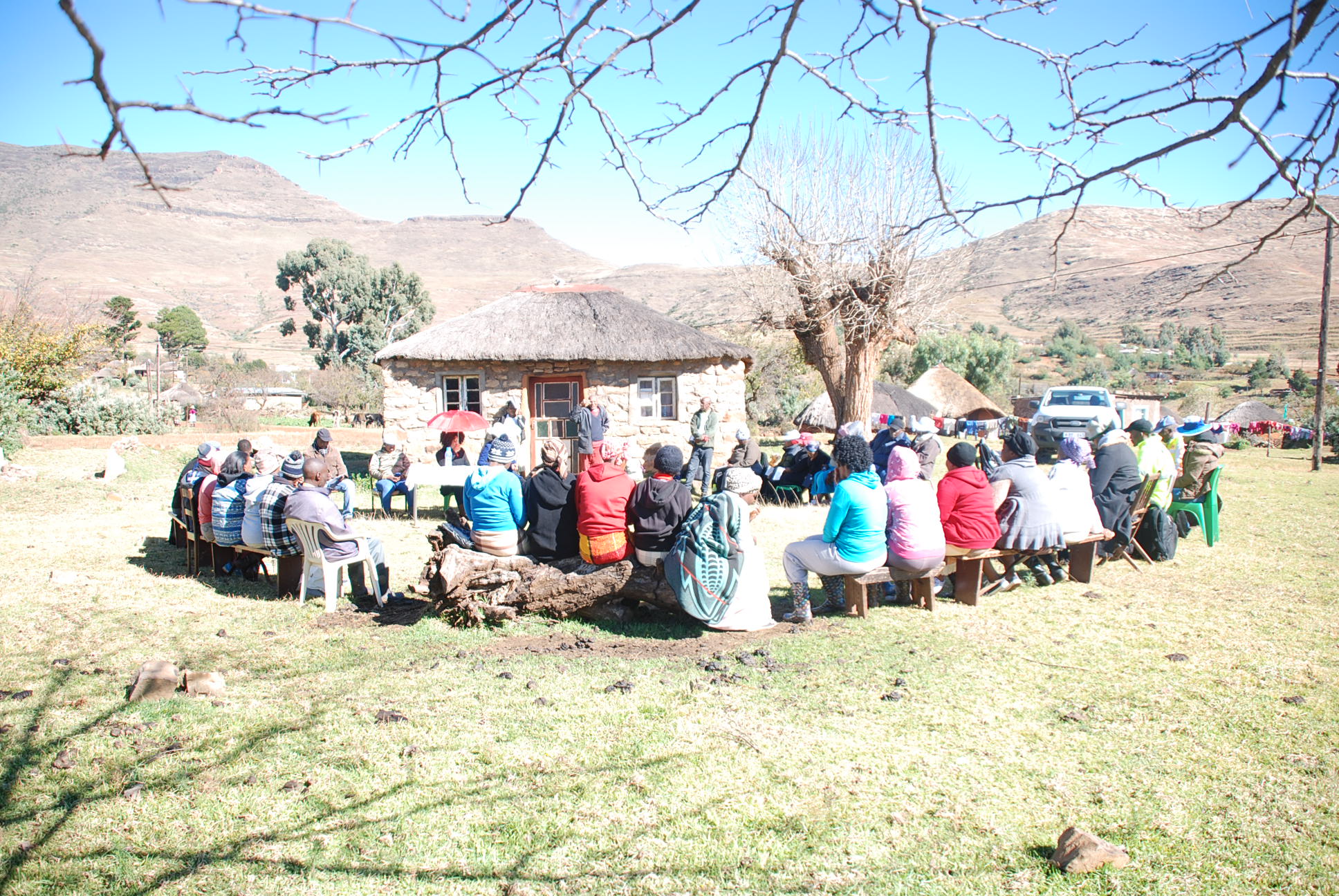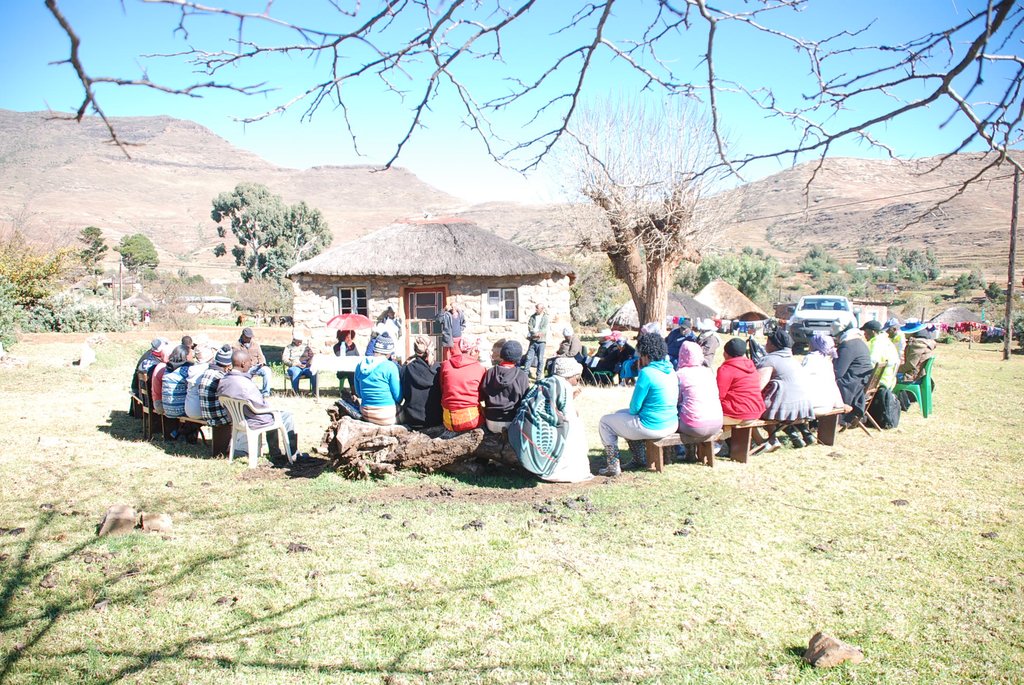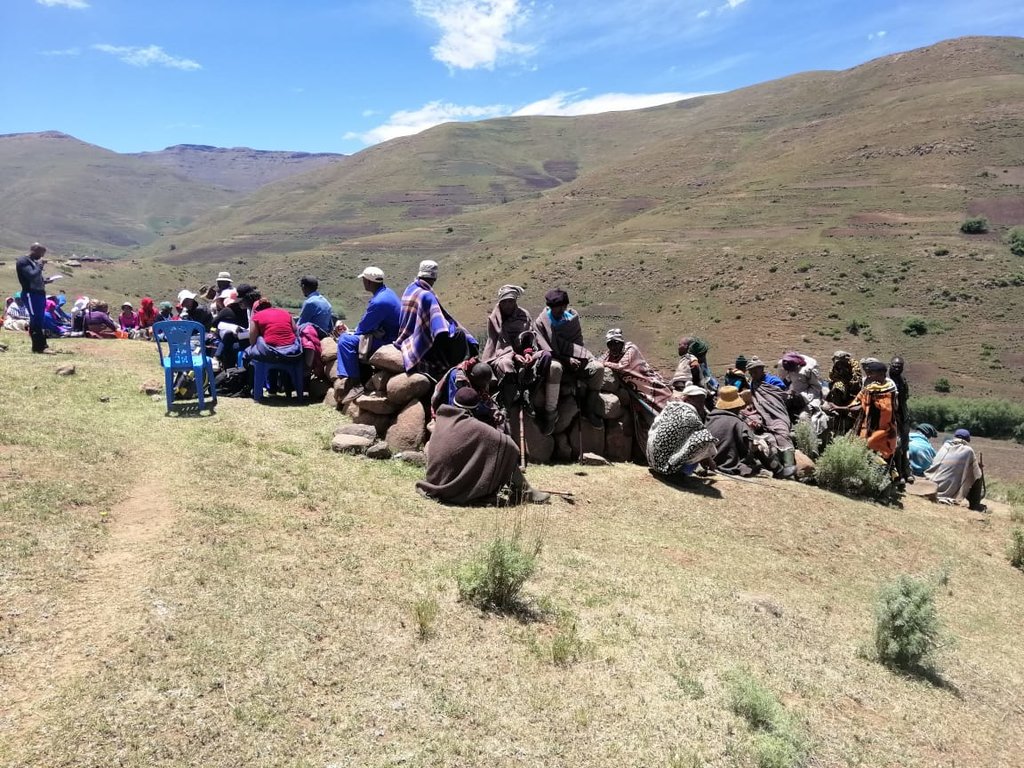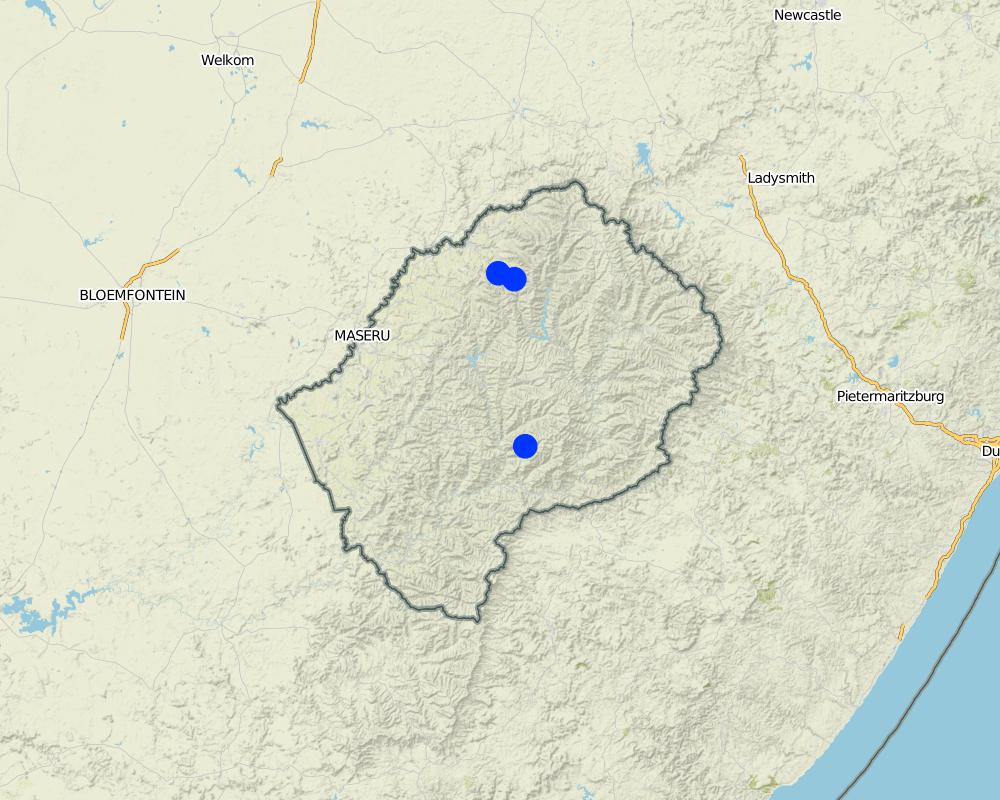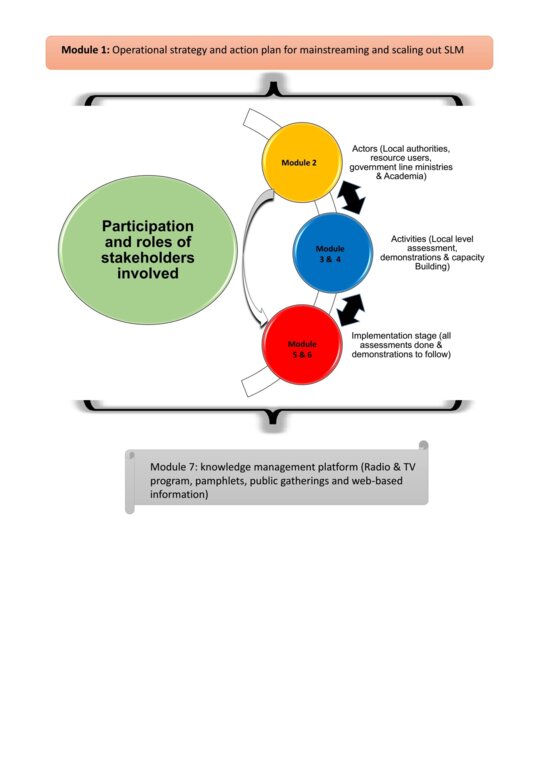Focus Group Discussion [เลโซโท]
- ผู้สร้างสรรค์:
- การอัพเดท:
- ผู้รวบรวม: Matoka Moshoeshoe
- ผู้เรียบเรียง: –
- ผู้ตรวจสอบ: Rima Mekdaschi Studer, William Critchley
Pitso
approaches_4266 - เลโซโท
ดูส่วนย่อย
ขยายทั้งหมด ย่อทั้งหมด1. ข้อมูลทั่วไป
1.2 รายละเอียดที่ติดต่อได้ของผู้รวบรวมและองค์กรที่เกี่ยวข้องในการประเมินและการจัดเตรียมทำเอกสารของแนวทาง
ชื่อของโครงการซึ่งอำนวยความสะดวกในการทำเอกสารหรือการประเมินแนวทาง (ถ้าเกี่ยวข้อง)
Decision Support for Mainstreaming and Scaling out Sustainable Land Management (GEF-FAO / DS-SLM)ชื่อของโครงการซึ่งอำนวยความสะดวกในการทำเอกสารหรือการประเมินแนวทาง (ถ้าเกี่ยวข้อง)
Integrated Catchment Management Project (Integrated Catchment Management Project) - เลโซโท1.3 เงื่อนไขที่เกี่ยวข้องกับการใช้ข้อมูลที่ได้บันทึกไว้ผ่านทาง WOCAT
วันที่เก็บรวบรวมข้อมูล (ภาคสนาม):
27/05/2018
ผู้รวบรวมและวิทยากรหลักยอมรับเงื่อนไขเกี่ยวกับการใช้ข้อมูลที่ถูกบันทึกผ่านทาง WOCAT:
ใช่
1.4 การอ้างอิงถึงแบบสอบถามเรื่องเทคโนโลยี SLM
2. คำอธิบายของแนวทาง SLM
2.1 การอธิบายแบบสั้น ๆ ของแนวทาง
This focus group discussion was composed of 15-20 participants: community elders, youth, (males and females as informed by local beliefs and norms), retired government officials.The aim of community focus group discussion was to find land users’perception and behaviour on land uses and SLM. It was organised by Ministry of Forestry, LADA coordinator and national consultant. The target group was land users, local authorities, youth, small stock owners, retired government officials. The target group mandate was also to draw the community map which also showed the land uses and resources. This focus group discussion gave researchers information on land uses, natural resources, prior SLM interventions, and many more.
2.2 การอธิบายอย่างละเอียดของแนวทาง
การอธิบายอย่างละเอียดของแนวทาง:
1. Conducted an initial field visit before the focus group discussion (FGD) with the selected villages within the sub-catchment: A tour by road with a few key informants to familiarise officers with the study area, land uses, also the extent and severity of degradation and types and extent of conservation and improved land management measures with the result being a community territorial map.
2. The aim of Focus Group Discussion (FGD) is to obtain information about range of land-users, their individual and communal management regime and the history of their area. This method is used as the first stage of implementation in LADA local level assessment.
3. The FGD representatives consisted of different social groups (i.e. both men and women – and different age groups) between 15-20 members. These members together with technocrats sat at round table set up which enabled free and interactive communication and feedback.
Each study area had its own list of FGD questions and facilitated them accordingly. Field Assessments confining; six (6) study areas in each sub-catchment.
•Vegetation assessment.
•Soil assessments which entail soil erosion and soil properties (2 study areas).
•Water resources assessment with key informant interviews on water resources.
•Household livelihood assessments.
•Land use systems
4. The target group mandate was also to draw the community map which also showed the land uses and resources. This focus group discussion gave researchers information on land uses, natural resources, prior SLM interventions, and many more. This approach enabled land users to present all their views without fear or dominance by other members. They realised that they have their resources in abundance, however, they need to improve their status as their livelihoods entirely depends on their good use.
5. It was organised by Ministry of Forestry, National University of Lesotho, Ministry of Agriculture, Ministry of Water, Ministry of Local Government,LADA coordinator and national consultant. The target group was land users, local authorities, youth, small stock owners, retired government officials.
6. The advantage of FGD was that the land users were taught on income generating activities such as orchard establishment, food processing, vegetable production under shade nets/tunnels (climate smart agriculture). They did not like the timing of FGD because it interfered with their haresting season, it took longer than it was intended and the weather conditions were not condusive as it was too cold and on the second day, snow began to fall.
2.3 รูปภาพของแนวทาง
2.4 วีดีโอของแนวทาง
ความคิดเห็น อธิบายสั้นๆ:
No videos taken
วันที่:
13/12/2018
สถานที่:
Maseru
ชื่อของผู้ถ่ายวีดีโอ:
N/A
2.5 ประเทศ ภูมิภาค หรือสถานที่ตั้งที่ได้นำแนวทางไปใช้
ประเทศ:
เลโซโท
ภูมิภาค/รัฐ/จังหวัด: :
Southern Africa
ข้อมูลเฉพาะเพิ่มเติมของสถานที่ตั้ง:
Focus group discussions were held in three different catchments (Ha Mahloane, Bolahla Pitseng in Leribe district, Lesobeng khutlo se-metsi catchment in Thaba-Tseka district and Ha mosuoe catchment in Quthing district.
ความคิดเห็น:
Bolahla-Mphosong catchment
Map
×2.6 วันที่เริ่มต้นและสิ้นสุดของแนวทาง
ถ้าไม่รู้ปีที่แน่นอนให้ประมาณวันที่ที่ริเริ่มใช้แนวทางนี้ :
10-50 ปี
การสิ้นสุดลง (ถ้าแนวทางไม่ได้ใช้อีกต่อไป):
2030
ความคิดเห็น:
On-going
2.7 ประเภทของแนวทาง
- ใช้โครงงานหรือแผนงานเป็นฐาน
2.8 เป้าหมายหรือวัตถุประสงค์หลักของแนวทาง
To find land-users views on their status of their natural resources and if they have indigenous knowledge systems applicable to be used in the management method
2.9 เงื่อนไขที่เอื้ออำนวยหรือเป็นอุปสรรคต่อการนำเทคโนโลยีภายใต้แนวทางนี้ไปปฏิบัติใช้
บรรทัดฐานและค่านิยมทางสังคม วัฒนธรรม ศาสนา
- เอื้ออำนวย
socio-economic factors can hinder the application of this technology
การมีไว้ให้หรือการเข้าถึงแหล่งการเงินและบริการ
- เอื้ออำนวย
FAOLS country office assisted with finances
การจัดตั้งระดับองค์กร
- เอื้ออำนวย
The Lesotho government has provided all conditions necessary
การร่วมมือหรือการทำงานประสานกันของผู้ลงมือปฏิบัติ
- เอื้ออำนวย
Other line ministries have fully participated
กรอบแนวทางในการดำเนินการด้านกฎหมาย (การถือครองที่ดิน สิทธิในการใช้ที่ดินและน้ำ)
- เป็นอุปสรรค
Lesotho land tenure needs to be reviewed
นโยบาย
- เป็นอุปสรรค
The Department of Soil and Water Conservation's policy is still in its draft form.
การกำกับดูแลที่ดิน (การตัดสินใจ การนำเอาไปปฏิบัติใช้ และการบังคับใช้)
- เป็นอุปสรรค
In Lesotho, land is communally owned
ความรู้เกี่ยวกับ SLM การเข้าถึงการสนับสนุนด้านเทคนิค
- เอื้ออำนวย
Farmer-Extension worker ratio is too high to enable adequate scaling up of SLM technologies
ตลาด (จัดซื้อปัจจัยนำเข้า ขายผลิตภัณฑ์) และราคา
- เป็นอุปสรรค
limited subsidies towards direct sourcing of specific inputs
ปริมาณงานที่ทำได้ กำลังคนที่มีให้
- เป็นอุปสรรค
Farmer-Extension worker ratio is too high to enable adequate scaling up of SLM technologies
3. การมีส่วนร่วมและบทบาทของผู้มีส่วนได้ส่วนเสียที่เกี่ยวข้อง
3.1 ผู้มีส่วนได้ส่วนเสียที่เกี่ยวข้องในแนวทางนี้และบทบาท
- ผู้ใช้ที่ดินระดับท้องถิ่นหรือชุมชนระดับท้องถิ่น
farmers, traditional healers
participants
- ผู้เชี่ยวชาญ SLM หรือที่ปรึกษาการเกษตร
soil scientists, agriculturalists, environmentalists and hydrologists
facilitators
- นักวิจัย
National University of Lesotho (natural resource management researchers)
facilitators/reseachers
- รัฐบาลระดับท้องถิ่น
Chiefs and Local councillors
community organisers
- รัฐบาลแห่งชาติ (ผู้วางแผน ผู้ทำการตัดสินใจ)
Soil and Water resource line ministries
planning, mentoring and decision support
ถ้ามีผู้มีส่วนได้ส่วนเสียหลายคนที่เกี่ยวข้องให้ระบุหน่วยงานตัวแทน:
Ministry of Forestry, Range and Soil Conservation
3.2 การเกี่ยวข้องของผู้ใช้ที่ดินระดับท้องถิ่นหรือชุมชนระดับท้องถิ่นในช่วงต่างๆของแนวทาง
| ความเกี่ยวข้องของผู้ใช้ที่ดินระดับท้องถิ่นหรือชุมชนระดับท้องถิ่น | ระบุผู้ที่มีส่วนเกี่ยวข้องและอธิบายกิจกรรม | |
|---|---|---|
| การริเริ่มหรือการจูงใจ | ปฏิสัมพันธ์ | key informants as community representatives |
| การวางแผน | ปฏิสัมพันธ์ | key informants and technocrats working together to produce community maps |
| การดำเนินการ | ปฏิสัมพันธ์ | technocrats tour guided by community elders |
| การติดตามตรวจสอบหรือการประเมินผล | ไม่มี | |
| ไม่มี |
3.3 แผนผังแสดงขั้นตอนการทำงาน (ถ้ามี)
คำอธิบาย:
This flow chart describes participation of stakeholders in the implementation of DS-SLM activities in Lesotho
ผู้เขียน:
Koetlisi Koetlisi (PhD) and Matoka Moshoeshoe
3.4 การตัดสินใจเลือกใช้เทคโนโลยี SLM
ระบุผู้ที่ทำการตัดสินใจเลือกเทคโนโลยีมากกว่าหนึ่งวิธีไปปฏิบัติใช้:
- ผู้เชี่ยวชาญ SLM เป็นผู้ตัดสินใจหลัก ที่ติดตามให้คำปรึกษากับผู้ใช้ที่ดิน
การอธิบาย:
Technocrats recommend SLM activities to land-users who in turn adopt the suggested technologies attributed to their impact land-users' livelihoods
ระบุว่าการตัดสินใจตั้งอยู่บนพื้นฐานของ:
- การประเมินความรู้ SLM ที่ได้ทำการบันทึกไว้เป็นอย่างดี (การใช้ข้อมูลในการตัดสินใจ)
4. การสนับสนุนด้านเทคนิค การสร้างขีดความสามารถ และการจัดการด้านความรู้
4.1 การสร้างขีดความสามารถ / การอบรม
ได้มีการจัดอบรมให้แก่ผู้ใช้ที่ดินหรือผู้มีส่วนได้ส่วนเสียคนอื่น ๆ หรือไม่:
ไม่ใช่
4.2 การบริการให้คำแนะนำ
ผู้ใช้ที่ดินมีการเข้าถึงการรับบริการให้คำปรึกษาหรือไม่:
ใช่
ระบุว่ามีบริการให้คำปรึกษาหรือไม่:
- ไปเยี่ยมชมสถานที่
- ที่ศูนย์ถาวร
การอธิบาย/แสดงความคิดเห็น:
There are farmer-farmer visits facilitated by extension workers. There are also agriculture resource centres whereby farmers visit to get more information.
4.3 การเสริมความแข็งแกร่งให้กับสถาบัน (การพัฒนาองค์กร)
สถาบันได้รับการจัดตั้งขึ้นมาหรือเสริมความแข็งแกร่งโดยแนวทางนี้หรือไม่:
- ไม่
4.4 การติดตามตรวจสอบและประเมินผล
การติดตามตรวจสอบและประเมินผลเป็นส่วนหนึ่งของแนวทางหรือไม่:
ไม่ใช่
4.5 การวิจัย
การวิจัยเป็นส่วนหนึ่งของแนวทางหรือไม่:
ใช่
ระบุหัวข้อเรื่อง:
- สังคมวิทยา
- เศรษฐศาสตร์หรือการตลาด
- นิเวศวิทยา
ให้ข้อมูลเพิ่มเติมและให้ระบุผู้ทำการวิจัย:
Each researcher facilitated their area of speciality and this enabled the question-answer session to be easy. community members had bottle-necks which researchers ironed. The challenge in extension services is means of transport to the landusers due to terrain of our country, so extension service is somehow compromised and not acessible at all times.
5. การสนับสนุนด้านการเงินและวัสดุอุปกรณ์
5.1 ระบุงบประมาณประจำปีสำหรับแนวทาง SLM นี้
ถ้าหากว่างบประมาณประจำปีไม่เป็นที่ทราบแน่นอน ให้ระบุช่วงลงไป:
- 2,000-10,000
แสดงความคิดเห็น (แหล่งของการระดมทุน ผู้บริจาคคนสำคัญ):
FAO-UN
Government of Lesotho
The money caters for accomodation, meals, transport, refreshments for researchers. This is because reseachers do not reside where the FGD was taking place, after the FGD followed LADA local level assessment, which was conducted for 15 days.
5.2 การสนับสนุนด้านการเงิน / วัสดุอุปกรณ์ให้แก่ผู้ใช้ที่ดิน
ผู้ใช้ที่ดินได้รับการสนับสนุนด้านการเงิน / วัสดุอุปกรณ์ไปปฏิบัติใช้เทคโนโลยีหรือไม่:
ไม่ใช่
5.3 เงินสนับสนุนสำหรับปัจจัยนำเข้า (รวมถึงแรงงาน)
- ไม่มี
ความคิดเห็น:
N/A
5.4 เครดิต
มีการจัดหาเครดิตมาให้ภายใต้แนวทาง SLM หรือไม่:
ไม่ใช่
5.5 แรงจูงใจหรือเครื่องมืออื่น ๆ
แรงจูงใจหรือเครื่องมืออื่น ๆ ได้ถูกนำไปใช้ส่งเสริมการใช้เทคโนโลยี SLM หรือไม่:
ใช่
ถ้าใช่ ระบุ:
There are policies and laws which were referred to in order to support SLM such as Forest Act (1998), Range Resources Management policy (2013)
6. การวิเคราะห์ผลกระทบและการสรุป
6.1 ผลกระทบของแนวทาง
ช่วยในการตัดสินใจโดยดูจากหลักฐาน ได้หรือไม่:
- ไม่ใช่
- ใช่ เล็กน้อย
- ใช่ ปานกลาง
- ใช่ อย่างมาก
participants exchanged information without any hindrance as they were able to learn based on their baseline knowledge
ช่วยให้ผู้ใช้ที่ดินนำเอาเทคโนโลยี SLMไปใช้และบำรุงรักษาสภาพไว้ได้หรือไม่:
- ไม่ใช่
- ใช่ เล็กน้อย
- ใช่ ปานกลาง
- ใช่ อย่างมาก
Land users were only given a theory on the importance of SLM technologies not how technologies are constructed. other researchers were novice in land management, it is though this approach where they learned facilitation skills. In Lesotho, land management activities are implemented mostly by women, youth and elderly because men in the villages work in South African mines. The picture of FGD also portrays more women than men
ปรับปรุงความร่วมมือกันและการดำเนิน งานของ SLM ได้อย่างมีประสิทธิผลหรือไม่:
- ไม่ใช่
- ใช่ เล็กน้อย
- ใช่ ปานกลาง
- ใช่ อย่างมาก
This was not part of the agenda
ปรับปรุงความรู้และความสามารถของผู้ใช้ที่ดินในการดำเนินการ SLM หรือไม่:
- ไม่ใช่
- ใช่ เล็กน้อย
- ใช่ ปานกลาง
- ใช่ อย่างมาก
It was agreed that participants would take part in demonstrations that would be implemented later in their respective communities
ปรับปรุงความรู้และความสามารถของผู้มีส่วนได้ส่วนเสียคนอื่น ๆ ให้ดีขึ้นหรือไม่:
- ไม่ใช่
- ใช่ เล็กน้อย
- ใช่ ปานกลาง
- ใช่ อย่างมาก
All stakeholders in the natural resources management had a chance to discuss collectively- not in silos, issues that concerned them
ทำให้ผู้ใช้ที่ดินระดับท้องถิ่นมีอำนาจขึ้น ปรับปรุงการเข้าร่วมของผู้มีส่วนได้ส่วนเสียให้ดีขึ้นหรือไม่:
- ไม่ใช่
- ใช่ เล็กน้อย
- ใช่ ปานกลาง
- ใช่ อย่างมาก
All stakeholders in the natural resources management had a chance to discuss collectively- not in silos, issues that concerned them. Presence of researchers strengthened this collaboration.
ทำให้กลุ่มด้อยโอกาสมีอำนาจทางสังคมและเศรษฐกิจหรือไม่:
- ไม่ใช่
- ใช่ เล็กน้อย
- ใช่ ปานกลาง
- ใช่ อย่างมาก
ปรับปรุงความทัดเทียมกันด้านเพศและให้อำนาจแก่ผู้หญิงและเด็กผู้หญิงหรือไม่:
- ไม่ใช่
- ใช่ เล็กน้อย
- ใช่ ปานกลาง
- ใช่ อย่างมาก
all levels of society were represented
ส่งเสริมให้เยาวชนหรือบุตรหลานของผู้ใช้ที่ดินให้เข้าร่วมใน SLM:
- ไม่ใช่
- ใช่ เล็กน้อย
- ใช่ ปานกลาง
- ใช่ อย่างมาก
The youth were also represented
ปรับปรุงประเด็นของการถือครองที่ดินหรือสิทธิในการใช้ ซึ่งขัดขวางการนำเทคโนโลยีไปใช้ให้ดีขึ้น:
- ไม่ใช่
- ใช่ เล็กน้อย
- ใช่ ปานกลาง
- ใช่ อย่างมาก
Lesotho land tenure issues need to be addressed at national level
นำไปสู่ความมั่นคงด้านอาหารหรือปรับปรุงโภชนาการให้ดีขึ้น:
- ไม่ใช่
- ใช่ เล็กน้อย
- ใช่ ปานกลาง
- ใช่ อย่างมาก
Officers from Ministry of Agriculture through extension, delivered issues of nutrition and food security
ปรับปรุงการเข้าถึงตลาดหรือไม่:
- ไม่ใช่
- ใช่ เล็กน้อย
- ใช่ ปานกลาง
- ใช่ อย่างมาก
There is abundance of natural resources in this area. Members were made aware of markets opportunities around them
นำไปสู่การเข้าถึงเรื่องน้ำและสุขาภิบาลได้ดีขึ้นหรือไม่:
- ไม่ใช่
- ใช่ เล็กน้อย
- ใช่ ปานกลาง
- ใช่ อย่างมาก
Officers from Ministry of Water advised on issues of water and sanitation
นำไปสู่การใช้ที่ดินอย่างยั่งยืนหรือแหล่งพลังงานหรือไม่:
- ไม่ใช่
- ใช่ เล็กน้อย
- ใช่ ปานกลาง
- ใช่ อย่างมาก
The community entirely depends on the natural resources for better livelihoods
ปรับปรุงความสามารถของผู้ใช้ที่ดินในการปรับตัวให้เข้ากับการเปลี่ยนแปลงของสภาพภูมิอากาศหรือสภาพที่รุนแรงและภัยพิบัติหรือไม่:
- ไม่ใช่
- ใช่ เล็กน้อย
- ใช่ ปานกลาง
- ใช่ อย่างมาก
Climate change issues were also discussed and participants were made aware of the effects.
นำไปสู่โอกาสในการจ้างงาน รายได้หรือไม่:
- ไม่ใช่
- ใช่ เล็กน้อย
- ใช่ ปานกลาง
- ใช่ อย่างมาก
Key informants were asked about their means of livelihoods in the area. This opened income opportunities to some members
6.2 แรงจูงใจหลักของผู้ใช้ที่ดินเพื่อที่จะนำ SLM ไปปฏิบัติใช้
- การผลิตที่เพิ่มขึ้น
Land productivity has been declining attributed to land degradation. SLM is seen as the only measure to help farmers in increasing their production
- การเสื่อมของที่ดินลดลง
Lesotho's landscape is severely eroded. Land users would like use SLM as an approach to halt land degradation
6.3 ความยั่งยืนของกิจกรรมของแนวทาง
ผู้ใช้ที่ดินสามารถทำให้สิ่งต่างๆ ที่ได้ปฏิบัติใช้โดยแนวทางนี้ยั่งยืนได้หรือไม่ (โดยไม่มีการสนับสนุนจากภายนอก):
- ไม่แน่ใจ
ถ้าตอบว่าไม่หรือไม่แน่ใจ ให้ระบุและแสดงความคิดเห็น :
Without external support, farmers are not able to implement activities fully
6.4 จุดแข็งและข้อได้เปรียบของแนวทาง
| จุดแข็ง / ข้อได้เปรียบของแนวทางในทัศนคติของผู้ใช้ที่ดิน |
|---|
| Knowledge management |
| It can easily be implemented |
| It brings different land user groups together |
| จุดแข็ง / ข้อได้เปรียบของแนวทางในทัศนคติของผู้รวบรวมหรือวิทยากรหลัก |
|---|
| other key resource persons such as local authorities liked this approach because it them ideas on which resources are available in the catchment and how communities utilise them for survival. The land users on the other hand ound this approach very useful as they were empowered and allowed to say their views without fear or favor as they were informed that there were no wrong answers. everybody participated fully |
6.5 จุดอ่อน / ข้อเสียเปรียบของแนวทางและวิธีในการแก้ไข
| จุดอ่อน / ข้อเสียเปรียบในทัศนคติของผู้ใช้ที่ดิน | สามารถแก้ไขปัญหาได้อย่างไร |
|---|---|
| It is limited to key informants | It should be replicated within the same community but, with different participants (Key) |
| Some key informants tend to dominate the discussion | The facilitator should be observant and try to control dominating participants |
| It may become a platform for conflicts | Local authorities should be present in case conflicts arise |
7. การอ้างอิงและการเชื่อมต่อ
7.1 วิธีการหรือแหล่งข้อมูล
- ไปเยี่ยมชมภาคสนาม การสำรวจพื้นที่ภาคสนาม
15-25 informants, these are representatives of each village whereby each village was represented by 2/3 participants. these are the people who formed FGD
- การสัมภาษณ์กับผู้ใช้ที่ดิน
10% of total households per catchment
7.2 การอ้างอิงถึงสิ่งตีพิมพ์
ชื่อเรื่อง ผู้เขียน ปี ISBN:
N/A
7.3 เชื่อมโยงกับข้อมูลที่มีอยู่บนออนไลน์
ชื่อเรื่องหรือคำอธิบาย:
Ministry of Forestry, Range and Soil Conservation
URL:
https://forestry.gov.ls
ชื่อเรื่องหรือคำอธิบาย:
Lesotho Soil Information System
URL:
https://lesis.gov.ls
ลิงก์และโมดูล
ขยายทั้งหมด ย่อทั้งหมดลิงก์
ไม่มีลิงก์
โมดูล
ไม่มีโมดูล


